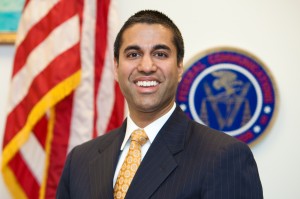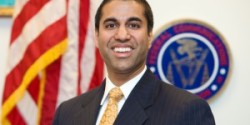
FCC Commissioner Ajit Pai is a fan of AM radio
The Commission makes five proposals to help make life easier for AM broadcasters and possibly ease some interference between stations. Many of the proposals are in response to filings made by the Minority Media Telecommunications Council. In a statement on this proposed rule making (PDF), Pai acknowledged this influence, saying the MMTC knows “that most minority-owned radio stations are on the AM band and that many AM stations serve ethnic and foreign-language populations.”
In her own statement (PDF) Clyburn said, “Female-owned and minority-owned stations make up a greater percentage of stations on the AM dial than the FM dial. And my professional career was buoyed on an AM station in South Carolina, so I have a special affection for the AM service and its place in our culture.”
Four of the FCC’s five proposals are intended to make it easier for existing AM stations to modify their transmissions or relocate their stations. Two of them would permit stations to reduce their coverage to the city of license during daytime and nighttime conditions, granting more flexibility in relocating a station. One proposal would allow stations to use shorter transmission antennas, giving them more flexibility in where this equipment can be installed, and one proposal would let stations use a newer technology called Modulation Dependent Carrier Level control techniques to lower power bills and operating costs.
The most significant proposal is the one to open a new licensing window for FM translator repeater stations, but only for AM station licensees. In 2009 the FCC began letting AM stations obtain translators on the FM dial, move which the Commission calls “an enormous success, with over 10 percent of all AM stations now using FM translators.” However, some stations have left out because they cannot move an existing translator into its current broadcast service area as defined by FCC rules. So the Commission proposes to give those stations their own opportunity to get a translator.
There would be a few restrictions, the primary one being that an AM station would only be allowed one FM translator. Importantly, trafficking in these stations would be prohibited.
“Any FM translator station authorized pursuant to this window will be permanently linked to the AM primary station acquiring it,” the FCC writes. “It makes little sense to provide AM broadcasters with an opportunity to enhance their service by applying for and receiving authorizations for new FM translator stations if those stations may then be assigned or transferred to independent parties unaffiliated with the primary AM stations, or used to rebroadcast other primary station signals.”
As two different classes of low-powered stations, translators and LPFM community stations ostensibly compete for space on the dial. But because any licensing window for AM stations would come after the last batch of FM translator licenses are assigned and the current LPFM filing window is completed, the FCC says such a move would pose “little to no detriment either to the FM translator service or to licensing opportunities for LPFM stations.”
Notably absent from the FCC’s specific proposals is the all-digital / HD Radio option which Pai first floated publicly at the annual National Association of Broadcasters show this past April. Pai reiterated his support for testing such a system–but not adopting an “anything goes” policy–at the NAB Radio Show in September.
Transitioning AM radio to all-digital would require listeners to buy new receivers, in addition to forcing transmitter upgrades for stations not currently broadcasting digital HD Radio. The advantage to all-digital AM is supposed to be a reduction of noise and interference. The disadvantage is that it would obsolete existing analog radios and transmitters.
The idea for all-digital AM was prominently advocated by CBS Radio’s Senior VP of Engineering Glynn Walden at the April NAB show. However, reception within the radio industry has been mixed. In May executives from Clear Channel met with Commissioner Pai to express some reservations. Clear Channel Vice President Jeff Littlejohn said, “It would be challenging for the Commission to set a date certain to convert AM stations to all digital broadcasts, given the investments necessary for such a transition by broadcasters, and on the reception side, the large percentage of analog radios in the market.”
If a significant goal of AM revitalization is to assist minority and women-owned stations, then it’s arguable that a push for all-digital would not necessarily aid this cause, given the financial burden it would impose on stations to upgrade. (Though the MMTC did ask the FCC to require HD Radio capabilities in satellite radios as a condition for the Sirius – XM merger.)
It’s reasonable to think that considerations like these influenced the FCC to leave the all-digital option off its initial slate of AM revitalization proposals. However, the Commission does ask for submission of other proposals, and specifically name-checks an all-digital conversion amongst the “ideas that have been proposal to assist in revitalizing AM radio.”
In his statement Pai does not mention the all-digital option at all, while he does cite the call for “creative ideas.”
As John Anderson reported, a few stations have been experimenting with all-digital AM broadcasts, in what he calls “The quiet collection of ‘evidence’ on which to justify an all-digital HD Radio mandate.” Therefore we should expect proposals to this rule making showcasing this test data coming from HD Radio owner iBiquity and other broadcasters.
The FCC’s proposals are just that: proposals. Therefore the commission is accepting public comments on them, as well as additional suggestions for improvements to the AM band. The deadline for submitting comments will be 60 days after notice of this rule making is published in the Federal Register. Then there will be an additional 90 days to submit replies to the comments that have been submitted.
We’ll keep a watch on submitted comments for anything interesting, and to get a sense for how the winds of the industry are blowing.



